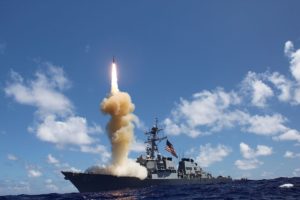By Bryce Farabaugh and Deverrick Holmes, Policy Interns
 This month marks the seventeenth anniversary of the United States withdrawal from the Anti-Ballistic Missile (ABM) Treaty, a landmark agreement from the Cold War that limited American and Soviet (and subsequently, Russian) ground-based, anti-ballistic missile defense systems. Originally signed May 26, 1972, between American President Richard Nixon and Soviet General Secretary Leonid Brezhnev, the treaty was designed to limit both sides’ missile defense capabilities and prevent the establishment of a large-scale (regional or nationwide) system that could minimize the impact of a nuclear strike and unsettle strategic stability. In hindsight, the treaty’s abandonment 17 years ago can be viewed as an opening salvo in the unraveling of the arms control system and American-Russian relations we see continuing to this day.
This month marks the seventeenth anniversary of the United States withdrawal from the Anti-Ballistic Missile (ABM) Treaty, a landmark agreement from the Cold War that limited American and Soviet (and subsequently, Russian) ground-based, anti-ballistic missile defense systems. Originally signed May 26, 1972, between American President Richard Nixon and Soviet General Secretary Leonid Brezhnev, the treaty was designed to limit both sides’ missile defense capabilities and prevent the establishment of a large-scale (regional or nationwide) system that could minimize the impact of a nuclear strike and unsettle strategic stability. In hindsight, the treaty’s abandonment 17 years ago can be viewed as an opening salvo in the unraveling of the arms control system and American-Russian relations we see continuing to this day.
The intent to withdraw from the ABM treaty was formally announced by the George W. Bush administration in December 2001, shortly after the September 11 attacks and during a period in which policymakers were grappling with the new threats posed by terrorist organizations and “rogue states” rather than the decades-old threat of a great-power war. A nuclear weapon detonation in an American city by al Qaeda or a small number of missiles launched by a country like North Korea were viewed as more pressing threats to the American public than war with Russia, and the Bush administration argued that maintaining the ABM Treaty only restrained the United States from pursuing a missile defense system that could theoretically defend against one of those threats (rogue state actors.)
There was resistance to the withdrawal in some circles in Washington, D.C., however, as well as a concerted pushback from officials in Moscow. Delaware Senator and future Vice President Joe Biden issued a statement warning “unilaterally abandoning the ABM Treaty would be a serious mistake… the Administration has not offered any convincing rationale for why any missile defense test it may need to conduct would require walking away from a treaty that has helped keep the peace for the last 30 years.” Additionally, the head of the Russian armed forces at the time, Gen. Anatoly Kvashnin, predicted the pullout would “alter the nature of the international strategic balance in freeing the hands of a series of countries to restart an arms buildup.”
Only six months later, in June 2002, President Bush officially followed through on his threat to abandon the agreement, optimistically stating, “The ABM Treaty is a relic of the past. It prevents freedom-loving people from exploring the future, and that’s why we’ve got to lay it aside, and that’s why we’ve got to have the framework, the discussions necessary to explain to our friends and allies, as well as Russia, that our intent is to make the world more peaceful, not more dangerous.”
When the Bush Administration announced the withdrawal, he declared the United States would have a working ABM system by 2004. The system would come to be known as the Ground-based Midcourse Defense system (GMD). In order to meet such a tight development deadline, the entire system was rushed: proper testing and evaluations were not done, and the program hasn’t been able to recover. Since its deployment in 2004, the system has less than a 55 percent success record in highly scripted tests. In recent years, this poor performance, in conjunction with numerous other setbacks, has called the entire program into question.
The Government Accountability Office estimates that since U.S withdrawal from the treaty in 2002, the Missile Defense Agency has been allocated about $142 billion for various ballistic missile defense systems, with $67 billion going toward the GMD program. Advocates for missile defense have continued to point to “rogue states” as the justification for continued investments in GMD, even though its performance in testing scenarios has been inconsistent at best.
Since the withdrawal from the ABM Treaty 17 years ago, relations between Russia and the United States have deteriorated significantly, and despite the rosy predictions by President Bush and his administration at the time, the world is likely in a more dangerous situation today as countries race toward nuclear modernization and the development of new weapons technologies specifically designed to circumvent missile defense systems. Some fear the announced abandonment of the Intermediate-range Nuclear Forces Treaty, along with new Russian nuclear capabilities, could call into question the future of the New Strategic Arms Reduction Treaty and mark a near-complete unraveling of the decades-old arms control regime. Should the United States and Russia seek closer relations on nuclear weapons issues in the future, leaders from both countries will need to reassess the efficacy of missile defense systems and whether they contribute to the mutual goal of increasing international strategic stability.
